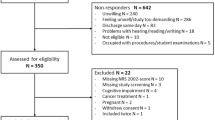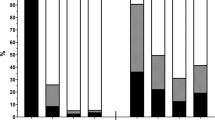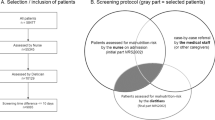Abstract
In 2015, an European Society for the Parenteral and Enteral Nutrition malnutrition diagnosis consensus was published to unify the definition and simplify the diagnostic procedure of malnutrition, in which 'nutritional risk', 'malnutrition risk' and 'at risk of malnutrition' were referred to several times, and 'at risk of malnutrition' was encouraged to be coded and reimbursed in the International Classification of Diseases and diagnosis-related group system systems. However, there may be some mistakes when using the concepts of different 'risk' mentioned above. In this study, we aimed to explain different 'risks' using the original concept by different screening tools to clarify the definition and provide a recommendation for nutritional screening.
This is a preview of subscription content, access via your institution
Access options
Subscribe to this journal
Receive 12 print issues and online access
$259.00 per year
only $21.58 per issue
Buy this article
- Purchase on Springer Link
- Instant access to full article PDF
Prices may be subject to local taxes which are calculated during checkout
Similar content being viewed by others
References
Cederholm T, Bosaeus I, Barazoni R, Bauer J, Van Gossum A, Klek S, et al. Diagnostic criteria for malnutrition: An ESPEN Consensus Statement. Clin Nutr. 2015;34:335–40.
Kondrup J, Alison SP, Elia M, Vellas B, Plauth M. Educational and Clinical Practice Committee, European Society of Parenteral and Enteral Nutrition (ESPEN). ESPEN Guidelines for Nutrition Screening 2002. Clin Nutr. 2003;2:415–21.
Mueler C, Compher C, Elen DM. American Society for Parenteral and Enteral Nutrition (A.S.P.E.N.) Board of Directors. A.S.P.E.N. clinical guidelines: Nutrition screening, assessment, and intervention in adults. JPEN J Parenter Enter Nutr. 2011;35:16–24.
Van Bokhorst-de van der Schueren MA, Guaitoli PR, Jansma EP, de Vet HC. Nutrition screening tools: does one size fit all? A systematic review of screening tools for the hospital setting. Clin Nutr. 2014;33:39–58.
Schindler K, Pernicka E, Laviano A, Howard P, Schütz T, Bauer P, et al. How nutritional risk is assessed and managed in European hospitals: a survey of 21, 007 patients findings from the 2007–8 cross-sectional nutrition Day survey. Clin Nutr. 2010;29:552–9.
Kondrup J, Rasmusen HH, Hamberg O, Stanga Z, Ad Hoc ESPEN Working Group. Nutritional risk screening (NRS2002): a new method based on an analysis of controlled clinical trials. Clin Nutr. 2003;22:321–36.
Jie B, Jiang ZM, Nolan MT, Efron DT, Zhu SN, Yu K, et al. Impact of nutritional support on clinical outcome in patients at nutritional risk: a multicenter, prospective cohort study in Baltimore and Beijing teaching hospitals. Nutrition. 2010;26:1088–93.
Jie B, Jiang ZM, Nolan MT, Zhu SN, Yu K, Kondrup J. Impact of preoperative nutritional support on clinical outcome in abdominal surgical patients at nutritional risk. Nutrition. 2012;28:1022–7.
Zhang H, Wang Y, Jiang ZM, Kondrup J, Fang H, Andrews M, et al. The impact of nutrition support on clinical outcome and cost-effectiveness analysis in patients at nutritional risk: a prospective cohort study with propensity score matching. Nutrition. 2017;37:53–59.
McClave SA, Taylor BE, Martindale RG, Warren MM, Johnson DR, Braunschweig C, et al. Guidelines for the Provision and Assessment of Nutrition Support Therapy in the Adult Critically Ill Patient: Society of Critical Care Medicine (SCCM) and American Society for Parenteral and Enteral Nutrition (A.S.P.E.N.). JPEN J Parenter Enter Nutr. 2016;40:159–211.
Skipper A, Ferguson M, Thompson K, Castellanos VH, Porcari J. Nutrition screening tools: an analysis of the evidence. JPEN J Parenter Enter Nutr. 2012;36:292–8.
American Dietetic Asociation. ADA evidence analysis manual [OL]. EdIc. 2005. http://www.adaevidencelibrary.com/topic.cfm?cat=1155&library=EAL. Accessed on 10 August 2016.
Guigoz Y, Vellas J, Garry P. Mini nutritional assessment: a practical assessment tool for grading the nutritional state of elderly patients. Facts Res Gerontol. 1994;4:15–59.
Rubenstein LZ, Harker JO, Salvà A, Guigoz Y, Vellas B. Screening for undernutrition in geriatric practice: developing the short□ form mini nutritional assessment (MNA-SF). J Gerontol A Biol Sci Med Sci. 2001;56:458–64.
Sánchez Mu ozLA, Calvo Reyes MC, Majo Carbajo Y, Barbado-Ajo J, Aragón De La Fuente MM, Artero-Ruiz EC, et al. Mini nutritional assessment (MNA) as nutrition screening tool in internal medicine. Advantages and disadvantages. Rev Clin Esp. 2010;210:429–37.
Vischer UM, Frangos E, Graf C, Gold G, Weiss L, Herrmann FR, et al. The prognostic significance of malnutrition assessed by the Mini Nutritional Assessment (MNA) in older hospitalized patients with a heavy disease burden. Clin Nutr. 2012;31:13–17.
Putwatana P, Reodecha P, Sirapongam Y, Lertsithichai P, Sumboonnanonda K. Nutrition screening tools and the prediction of postoperative infectious and wound complications: comparison of methods in presence of risk adjustment. Nutrition. 2005;21:691–7.
Donini LM, Savina C, Rosano A, De Felice MR, Tassi L, De Bernardini L, et al. MNA predictive value in the follow-up of geriatric patients. J Nutr Health Aging. 2003;7:282–93.
Ranhof AH, Gjen AU, Mowé M. Screening for malnutrition in elderly acute medical patients: the usefulness of MNA-SF. J Nutr Health Aging. 2005;9:21–25.
Nelemat F, Merjets J, Kruizenga H, van Ballegooijen H, van Bokhorst-de van der Schueren M. Comparison of five malnutrition screening tools in one hospital inpatient sample. J Clin Nurs. 2001;20:2144–52.
Elia M. The ‘MUST’ report. In: BAPEN, editor. Nutritional screening of adults: a multidisciplinary responsibility 2003.
Raslan M, Gonzalez MC, Dias MC, Nascimento M, Castro M, Marques P, et al. Comparison of nutritional risk screening tools for predicting clinical outcomes in hospitalized patients. Nutrition. 2010;26:721–6.
Henderson S, More N, Le E, Witham MD. Do the malnutrition universal screening tool (MUST) and Birmingham nutrition risk(BNR) score predict mortality in older hospitalized patients? BMC Geriatr. 2008;8:26.
White JV, Guenter P, Jensen G, Malone A, Schofield M, Academy of Nutrition and Dietetics Malnutrition Work Group; A.S.P.E.N. Malnutrition Task Force; A.S.P.E.N. Board of Directors. Consensus statement: Academy of Nutrition and Dietetics and American Society for Parenteral and Enteral Nutrition: characteristics recommended for the identification and documentation of adult malnutrition (undernutrition). JPEN J Parenter Enter Nutr. 2012;36:275–83.
Soeters P, Bozzetti F, Cynober L, Forbes A, Shenkin A, Sobotka L. Defining malnutrition: a plea to rethink. Clin Nutr. 2017;36:896–901.
Contents of National Essential Medicare and Reimbursement formulary of China. http://www.mohrss.gov.cn/gkml/xxgk/201702/t20170223_266775.html. Accessed on 12 July 12 2017.
Acknowledgements
We thank the member of [NUSOC multicenter cooperative group] who did good work in this field and provided evidence for this article.
Author information
Authors and Affiliations
Corresponding authors
Ethics declarations
Conflict of interest
The authors declare that they have no conflict of interest.
Rights and permissions
About this article
Cite this article
Xu, J., Jiang, Z. Different risk scores consider different types of risks: the deficiencies of the 2015 ESPEN consensus on diagnostic criteria for malnutrition. Eur J Clin Nutr 72, 936–941 (2018). https://doi.org/10.1038/s41430-018-0120-3
Received:
Revised:
Accepted:
Published:
Issue Date:
DOI: https://doi.org/10.1038/s41430-018-0120-3
This article is cited by
-
A Cross-Sectional Study of Glim-Defined Malnutrition Based on New Validated Calf Circumference Cut-Off Values and Different Screening Tools in Hospitalised Patients over 70 Years Old
The Journal of nutrition, health and aging (2020)



